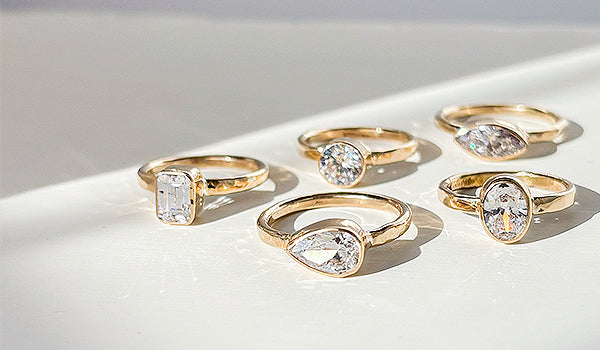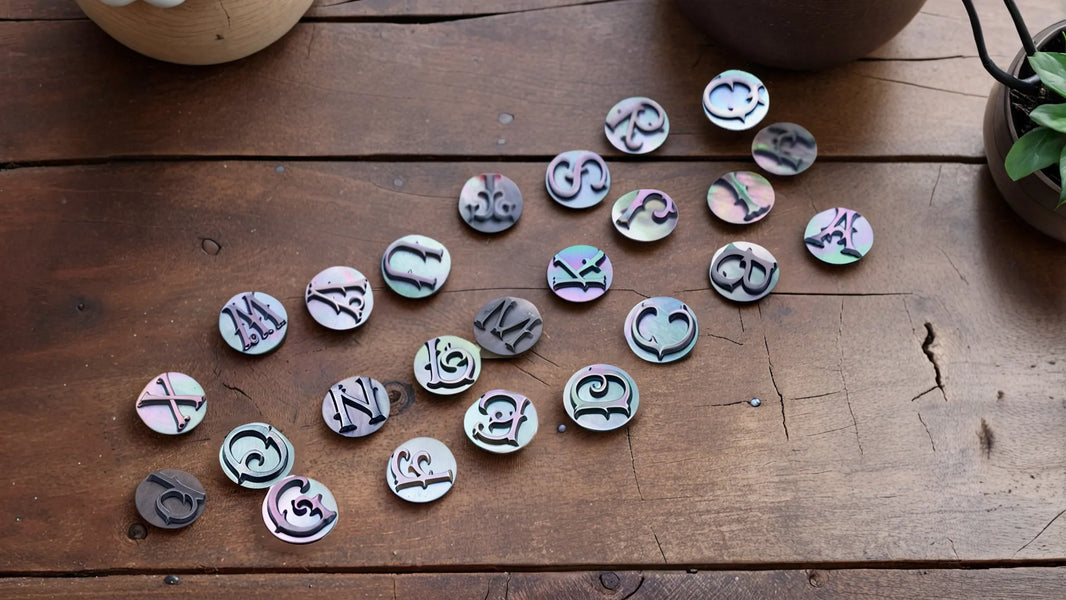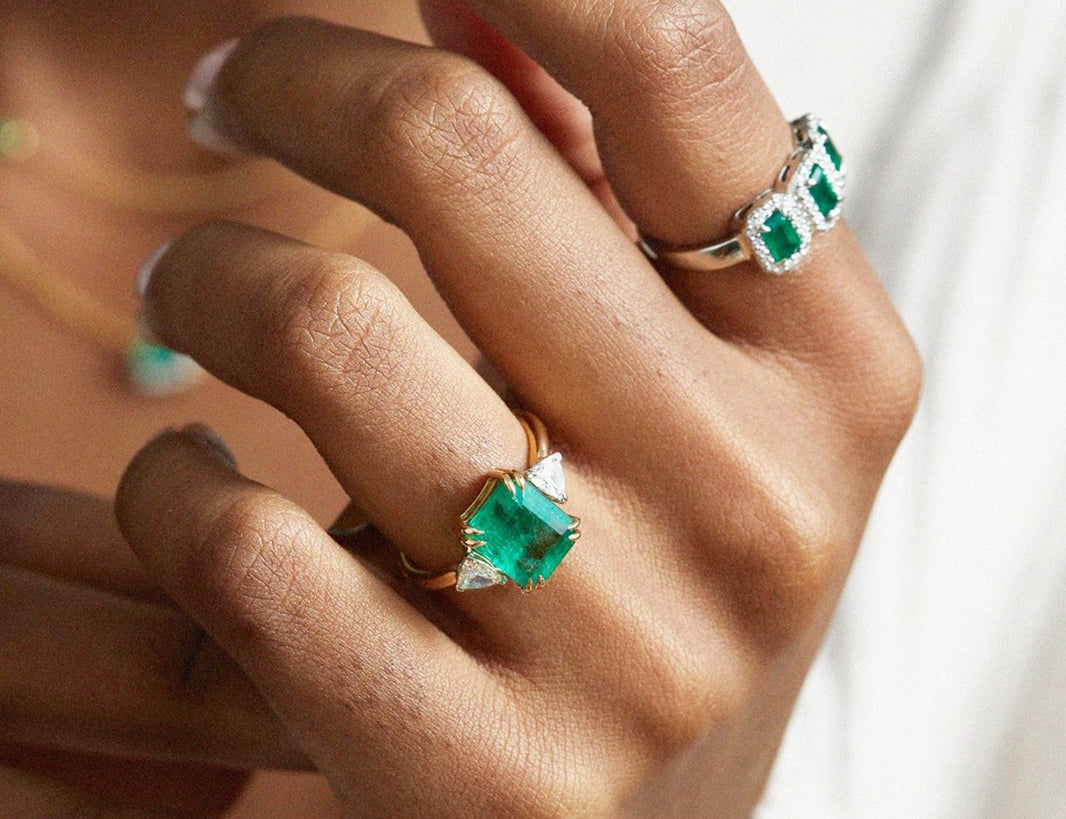Art Deco has never gone quiet; it simply waits for discerning eyes to rediscover its geometry, its spirit, and its cool conviction that modern life can be beautifully engineered. When you pair this iconic 1920s–1930s aesthetic with moissanite, you get a ring that blends Jazz Age architecture with contemporary ethics and value. As a jeweler who has inspected countless vintage mountings and modern Deco-inspired settings on the bench, I’ll guide you through what defines the look, how moissanite performs inside these designs, the metals and settings that matter, and how to choose, care for, and verify a piece you’ll be proud to wear every day.
Defining “Art Deco” in a Ring
Art Deco jewelry emerged from a world fascinated by speed, skyscrapers, and new materials. The style crystallized after the 1925 Paris exposition devoted to the decorative arts, and in rings it meant confident geometry, clean lines, and graphic contrasts. Antique Ring Boutique describes the period as geometric elegance, often realized through hallmark techniques like filigree and milgraining, and a strong preference for white metals that allowed intricate construction. Everything-Wedding-Rings.com characterizes the look as bold patterns that often integrated global motifs, with designers drawing inspiration from discoveries like the opening of King Tutankhamun’s tomb in 1922. Together, those sources help set an accurate north star: the Deco ring is a small piece of architecture.
Deco rings often showcase a prominent center framed by thoughtfully ordered shapes. Period-correct choices include step cuts such as emerald and Asscher, elongated marquise stones, and baguette accents that echo the streamlined modernism of the era. Platinum reigned for its strength and workability. As the 1930s progressed, white gold gained popularity as a more affordable alternative; you’ll also see some yellow and even rose gold in later or regional examples. Colored gems—sapphires, rubies, emeralds—mixed with diamonds to create striking contrasts, and synthetic stones became common for their affordability and bright color saturation, as Antique Ring Boutique notes.
A note on settings: pavé or channel?
You will encounter two credible narratives about “most typical” Deco settings. Antique Ring Boutique emphasizes widespread use of pavé, the glittering carpet of small stones that minimize visible metal. Everything-Wedding-Rings.com highlights the channel setting as the most popular of the period, where rows of stones are held between smooth metal walls. The difference likely comes from definitions and sample sets: wedding bands and dress rings of the time skew toward channels, while high-art pieces and platinum showstoppers turn readily to pavé. If you want to validate what best reflects the era you love, compare museum collections and period catalog reprints by category and region.

Why Moissanite Loves the Deco Aesthetic
Moissanite’s crisp sparkle and excellent durability work naturally with the hard edges and high symmetry of Art Deco forms. In my experience, moissanite’s lively scintillation reads as “electric” in geometric mounts, bringing life to architectural lines without overwhelming them. That’s especially true in bright environments that reward moissanite’s strong return of light.
Consider a modern Deco-inspired example from Eternate: a one-carat round, colorless-grade center set in a classic prong arrangement, offered in 14k or 18k gold and available in platinum by request. The diameter for a round one-carat equivalent typically measures roughly 0.26 in; specifications vary by make, so confirm dimensions with the seller. The key point is that moissanite’s availability across sizes and shapes makes Deco styling broadly accessible—without forcing compromises on the crispness of the design.
Cuts: step-cut gravitas or brilliant dazzle?
Historically, Deco adored step cuts like emerald and Asscher. Those long, mirror-like facets deliver a hall-of-mirrors glow rather than fireworks. Many modern Art Deco moissanite rings, however, use round or other brilliant cuts to emphasize scintillation. Based on bench comparisons, I find that brilliant cuts in moissanite amplify sparkle in pavé-heavy Deco layouts, while step cuts emphasize the clean geometry and tend to read more “period.” Both can be gorgeous; the right choice depends on whether you want performance or purity of style to take the lead.
Cut Type |
Visual Character |
How It Reads in Deco Settings |
Typical Appeal |
Confidence and Check |
Step cuts (emerald, Asscher) |
Broad, calm flashes and transparent “window” moments |
Emphasizes architectural geometry and symmetry |
Classic, tailored, vintage-leaning |
High; review photos and videos under diffuse daylight to confirm you like the subtler sparkle |
Brilliant cuts (round, oval) |
Lively, frequent sparkles and strong fire |
Animates pavé halos and geometric frames |
Bright, celebratory, contemporary-leaning |
High; compare side-by-side with a step cut under neutral LED light |
A brief overlooked nuance from modern offerings is the “hidden halo.” MoissaniteCo explains that hidden halos add chic side sparkle but do not necessarily make the center appear larger from the top view. That runs counter to some marketing language; it’s not a flaw, just a reminder to choose the feature for its profile beauty rather than an expectation of a bigger face-up look.

Metals and Finishes That Make Deco Sing
Period Deco gravitated to platinum and white gold for their crisp, icy effect and structural integrity. Contemporary moissanite designers work in these and other metals to tune both look and practicality. AnuClub’s guidance provides a clear snapshot of modern metal behavior for moissanite rings. Platinum is intensely durable and naturally white; white gold has a sleek look but often needs periodic rhodium replating; yellow gold is classic and warm but scratches more easily; rose gold’s copper content improves hardness and adds a romantic blush; palladium is lightweight, white, and hypoallergenic; sterling silver is budget-friendly but needs more care to resist tarnish and wear.
Metal |
Visual Tone |
Maintenance |
Hypoallergenic |
Where It Shines |
Source Notes |
Platinum |
Cool white, substantial |
Develops a soft sheen; polish as desired |
Yes |
Intricate Deco filigree and pavé where strength matters |
Antique Ring Boutique, AnuClub |
White gold |
Bright white with rhodium |
Rhodium replating restores whiteness as it wears |
Usually, but alloys vary |
Sleek, modern Deco lines; cost-effective vs. platinum |
AnuClub |
Yellow gold |
Warm, classic |
Shows scratches sooner; easy to refinish |
Alloy dependent |
Bold contrast with colorless moissanite; vintage-revival moods |
AnuClub |
Rose gold |
Blush pink |
Good surface durability; routine polish |
Copper content may be a concern for some |
Romantic Deco motifs, architectural halos with warmth |
AnuClub |
Palladium |
Natural white, lightweight |
Low-maintenance |
Yes |
Platinum-like appearance at a lighter feel |
AnuClub |
Sterling silver |
Cool white |
Tarnish management and more frequent polishing |
Alloy dependent |
Entry-budget Deco-inspired pieces; occasional wear |
AnuClub |
If you have sensitive skin, stick to platinum or palladium for predictable comfort. When in doubt, ask the jeweler for the specific alloy composition used for white or rose gold, and try the piece on for a few minutes to ensure comfort before committing.

Setting Architectures: From Period to Present
Deco settings are a masterclass in order: halos, linear baguette shoulders, and symmetrical frames that make the center stone look intentional rather than isolated. MoissaniteCo outlines several core styles you’ll encounter in Deco-inspired work.
Halos amplify a center stone with a precise border of small diamonds (or moissanites), throwing more light back to the eye. Solitaires lean into essentialism—an eloquent approach in squared or tapered shanks that echo skyscraper silhouettes. Hidden halos tuck sparkle just under the center, most visible from the side and a subtle way to honor Deco’s love of layered architecture. Bezels, where a rim of metal secures the stone, deliver a sleek profile and practical protection—a great fit for low-set, daily-wear Deco rings with step cuts or geometric shapes. East–West orientations rotate elongated stones horizontally to honor the period’s fascination with horizontals and speed lines. The infinity, or figure-eight motif, nods to modern symbolism while pairing cleanly with Deco halos. Three-stone arrangements create a balanced triptych, an idea very much at home in Deco symmetry.
Historically, you will also see channel-set bands and pavé-heavy tops. If you’re ordering a custom piece, ask the setter how they will protect small stones at the corners where channels meet pavé, and request close-up photos of the work under magnification before final approval.

How to Buy: A Connoisseur’s Checklist in Practice
Begin by deciding what part of Deco you want to wear every day. If your heart is set on period fidelity, look to step-cut centers in platinum with geometric shoulders. If you love sparkle within order, consider a round center in a crisp halo with baguette accents.
Next, choose your metal based on lifestyle and tone. If you work with your hands or prefer less maintenance, platinum’s density and natural whiteness are valuable. If you want a similar look at a lower price point, white gold is a smart choice; just budget for rhodium replating when the finish softens. If you crave warmth, yellow or rose gold can be wholly compatible with Deco structure; many contemporary pieces use warm metals intentionally to create striking contrast with the center.
Evaluate craftsmanship the way professionals do: by symmetry, finish, and the integrity of the small things. Crisp milgrain should be even and continuous. Pave beads should be uniform with no sharp snags. Inside the shank, look for smooth finishing with no burrs or uneven solder seams. Antique Ring Boutique underscores how period pieces show increased precision in metalwork; modern Deco-inspired rings should honor that standard.
Ask about hallmarks and maker’s marks, even on new builds. On vintage settings, check for original stamps and be cautious about resizing that could remove them. Everything-Wedding-Rings.com cautions that resizing may reduce value if hallmark areas are altered. If a ring must be sized, request the work be done away from stamped locations.
For retailers, accreditations and independent standards can build trust. Lily Arkwright, for example, highlights Assay Assured status and membership in the National Association of Jewellers; that means precious metal content is independently hallmarked. While those badges are UK-centric, the underlying principle applies anywhere: prefer sellers who embrace independent verification and publish clear policies on materials, sizing, returns, and warranty.
On the center stone, choose shapes aligned to your aesthetic, then verify basic specifications that matter to your eye. For a round one-carat equivalent, the face-up diameter is commonly in the vicinity of about 0.26 in, but maker-to-maker differences exist; request a measurement. If a product listing references colorless grades such as E–F or similar descriptors, ask for a standardized explanation of how that grading is determined for moissanite and whether the stone is described as colorless under daylight-balanced conditions. If content on a product page feels sparse, reach out for cut details, dimensions, and metal specifications before purchase.
One more practical note on authenticity. Everything-Wedding-Rings.com documents a major 1980s revival of Art Deco jewelry, which produced high-quality replicas mixed with mass-produced pieces. If you are buying a vintage mounting, request documentation and be wary of vague provenance. For Deco-inspired new pieces, the goal is not to mimic age, but to honor the blueprint with modern integrity.
Budget and value, without illusions
Moissanite’s greatest gift to Deco lovers is that it relocates budget from the center stone into craftsmanship, metal weight, and custom detailing. Promotions come and go, and brand offers can be confusing or even contradictory across pages, as seen in AnuClub marketing excerpts. Rather than chasing a headline discount, compare like for like: metal and alloy, weight, the quality of small stones, and the precision of finishing. Good Deco is about structure and intention—you’re investing in how a ring is made as much as what it holds.
Care and Maintenance for Daily Brilliance
Care routines should be simple, consistent, and respectful of small details. For weekly cleaning, warm water with a drop of mild dish soap and a soft brush keeps moissanite and diamonds bright; rinse thoroughly and dry with a lint-free cloth. This is widely accepted jeweler practice; if your retailer provides maintenance guidelines, follow those first. Every six months, ask a professional to check pavé and prongs, especially at corners and along channels where small stones take the most incidental knocks. White gold owners should plan for occasional rhodium replating to refresh the finish; the timeline depends on wear. Sterling silver will tarnish in open air; store it in a closed, dry pouch and use a gentle silver cloth as needed. If you own a vintage mounting, keep an eye on solder points, filigree, and any older repairs; small preventative touchups are less invasive than waiting for a break.
If you need a resize, clarify with the jeweler exactly where the cut will be made, and ensure any hallmarks or maker’s marks remain intact. As Everything-Wedding-Rings.com notes, losing those stamps can affect long-term value and provenance.
Overlooked but Useful Insights, Briefly Resolved
There is a recurring debate over whether pavé or channel settings are “the” classic Deco approach. The likely answer is that both are period-correct, with prevalence shaped by ring type and region, as detailed across Antique Ring Boutique and Everything-Wedding-Rings.com. The right choice for you should be guided by aesthetics and daily-wear considerations.
Modern Deco-inspired rings frequently showcase brilliant-cut moissanite centers even though period pieces favored step cuts. The reasoning is straightforward: moissanite’s lively scintillation complements today’s taste for sparkle, while step cuts serve purists seeking period gravitas. Decide by viewing each cut under the lighting you live in.
Hidden halos are elegant from the side, but don’t expect them to enlarge the top view of the center. MoissaniteCo is transparent about this; if your goal is maximum face-up presence, consider a classic halo with a precise outer diameter instead.

Frequently Asked Questions
How does moissanite compare to diamond in an Art Deco ring? From a style perspective, moissanite can deliver extraordinary brilliance within Deco geometry at a friendlier price point. If you prefer the calm glow of step cuts, choose an emerald or Asscher moissanite; if you want energy, a round brilliant suits a pavé or baguette-accented frame. For specifics on period authenticity or investment value, vintage diamonds in period settings remain their own category.
Which metal should I choose for a Deco-inspired moissanite ring? For strength and low maintenance, platinum is the benchmark. White gold offers a similar look with periodic rhodium replating. Yellow and rose gold add warmth that can look striking against a colorless center. If allergies are a concern, platinum and palladium are the safest bets, as summarized by AnuClub.
What settings are most true to the era? Architectural halos, linear baguette shoulders, and symmetrical frames are strong period cues. Antique Ring Boutique emphasizes pavé as widely used, while Everything-Wedding-Rings.com points to channels as especially popular. Both fit the Deco vocabulary; select based on comfort and daily wear.
Are hidden halos worth adding? They add profile sparkle and a refined layer without a busy top view. MoissaniteCo clarifies they don’t necessarily increase the center’s apparent size face-up, so choose them for side beauty rather than as a size enhancer.
How can I verify quality before buying online? Request macro photos or videos under neutral lighting, a precise measurement of the center’s face-up dimensions, and close-ups of pavé or channel work. Ask about alloy details, finishing on the inner shank, and resizing policies. For vintage settings, ask for hallmark images and avoid sizing that would remove stamps, echoing guidance from Everything-Wedding-Rings.com.
Takeaway
Art Deco moissanite rings succeed when the architecture comes first and the gemstone amplifies the structure. Draw on the era’s vocabulary—step-cut serenity or brilliant vitality, platinum exactness or the warmth of gold, halos or channels—and choose with intention. Use period-informed sources like Antique Ring Boutique for design context, Everything-Wedding-Rings.com for buying checks and authenticity tips, MoissaniteCo for modern setting behaviors, and AnuClub for metal realities and maintenance. With a deliberate eye and a jeweler’s respect for small details, you’ll land a ring that channels the Roaring Twenties with modern confidence—crisp, luminous, and ready to be lived in.
References
- https://4cs.gia.edu/en-us/blog/art-deco-engagement-rings-style/
- https://vtechworks.lib.vt.edu/bitstream/handle/10919/71382/Whiteley_BE_D_2016.pdf?s%09equence=2
- https://www.americangemsociety.org/complete-guide-to-art-deco-engagement-rings/
- https://www.everything-wedding-rings.com/art-deco-rings.html
- https://smart.dhgate.com/expert-tips-for-selecting-the-ideal-metal-for-your-custom-moissanite-ring/
- https://erstwhilejewelry.com/collections/art-deco-engagement-rings?srsltid=AfmBOorBWyZl7nWqVETuKLzojs8ZsCBfDTa0099BZsf0qVUYmbMs8Myx
- https://eternate.com/products/art-deco-moissanite-engagement-ring-1-00-ct?srsltid=AfmBOooEYnxBg-QqXDSP0k5a8FmZI7Qpb6KyUgsLIxmxzbO0tAgSFLg9
- https://www.flawlessmoissanite.com/products/copy-of-round-cut-moissanite-engagement-ring-art-deco-halo-design-choose-your-stone-size-metal
- https://www.gerrymartinez.com/art-deco-engagement-rings-gemstone/
- https://www.goldenbirdjewels.com/collections/vintage-engagement-rings?srsltid=AfmBOoqKs1r0NqpSjGmIULyHqQyfi4LHzTKFO-xwI6jHlOmHXFXaJ5Zh









